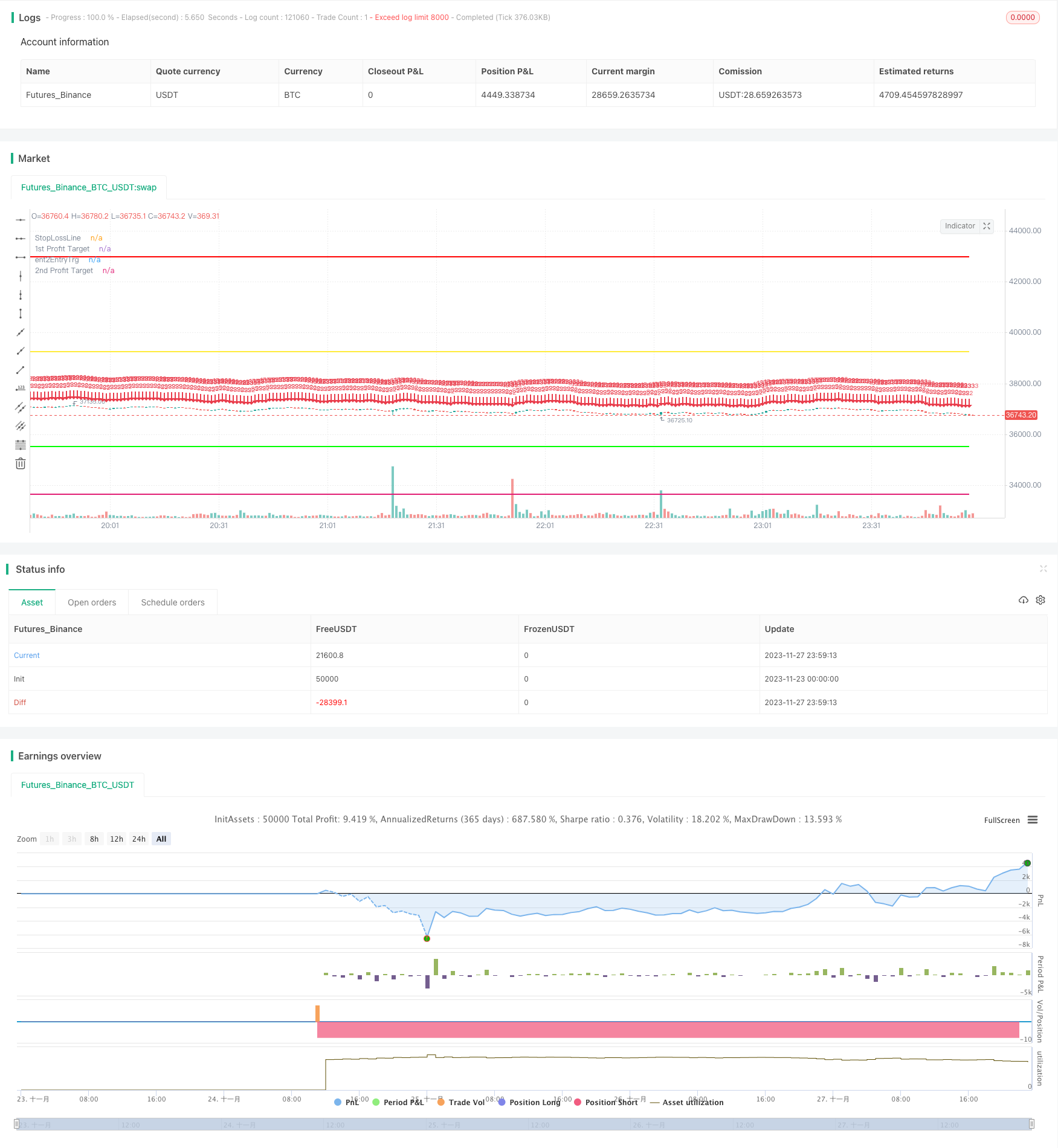
概述
该策略采用双入场的方式,在第一个入场点入场后,如果价格没有达到第一个止盈点,则在更高的价格再次入场,实现加仓的效果。同时,策略采用均价追踪止损的方式,实时更新止损线的位置,把止损线设置为入场均价的一定百分比以上,从而锁定利润,控制风险。
策略原理
策略首先判断价格是否低于200日简单移动平均线,如果是,则符合入场条件。策略在每天的14:29 - 15:00之间入场,形成第一个入场点。之后策略会绘制第一个止盈线和止损线。
如果价格上涨,但没有达到第一个止盈目标,则在第一个入场点比入场价格高5%的位置再次入场,实现加仓的效果。这个时候,策略会更新止损线的位置,将其设置为当前持仓的平均入场价的1.15倍。同时也会绘制出第二个止盈线。
该策略可以通过两个止盈目标和追踪止损来锁定利润,同时通过加仓来获得更多利润。
优势分析
该策略具有以下几个优势:
采用双入场加仓的方式,可以在不增加风险的前提下获得更高的收益。
实时更新止损线位置,采用均价追踪止损方式,可以很好的控制风险,锁定利润。
在跌势中开仓,具有一定的逆市操作能力。
入场时间和点位设置合理,避免被套。
参数设置合理,止盈止损点位够紧,收益风险比高。
风险分析
该策略也存在一些风险:
双入场加仓方式可能会放大损失。如果两个入场点最后都止损了,损失会加大。
如果止损点位设置不当,无法有效控制风险,可能导致超出可承受的损失。
如果入场时间选择不当,可能导致迎头入场,被套的概率大大增加。
参数设置如果不当,止盈点过远或者止损点过近,都可能导致收益下降。
这些风险可以通过合理的参数优化,严格的风险控制来减少和规避。
优化方向
该策略还可以从以下几个方向进行优化:
测试不同的技术指标作为入场条件,寻找更好的入场点位。
对止盈止损点位进行测试和优化,使收益风险比最大化。
测试不同的加仓方式,确定最优加仓倍数。
加入趋势判断规则,避免逆势入场。
优化入场时间段的选择,确保不会迎头入场。
总结
该策略总体来说非常实用,具有较强的实战意义。采用双入场加仓的方式可以在控制风险的前提下获得更高收益,均价追踪止损可以很好地锁定利润,控制风险。通过合理参数优化和严格风险控制,该策略可以获得稳定持续的Alpha。
/*backtest
start: 2023-11-23 00:00:00
end: 2023-11-28 00:00:00
period: 1m
basePeriod: 1m
exchanges: [{"eid":"Futures_Binance","currency":"BTC_USDT"}]
*/
// @version=4
strategy("8 Whittle Down", "8 WD", 1, initial_capital=0)
// DUAL ENTRIES
// ADDS ON MORE SHARES IF THE PILOT TRADE DOES NOT REACH PROFIT TARGET
// RED LINE == STOP LOSS LINE
// GREEN LINE == PROFIT TARGET FOR THE 1ST TRADE
// YELLOW LINE == ADD ON SHARES TO THE TRADE
// WHITE LINE == PROFIT TARGET FOR THE 1ST & SECOND TRADE COMBINED
StopLossPerc = input(1.15, "Total Stop Loss", step=0.01)
T2EntTrgPerc = input(1.05, "Enter Second trade @ what higher 5%?", step=0.01) // BUY STOP LIMIT ONLY WHEN ONE TRADE IS ALREADY OPEN & AIMS TO BUY DOUBLE THE OWNED SHARES AT A HIGHER ENTRY PRICE // YELLOW LINE
T1ProfTrgPerc = input(0.95, "First Trade Profit % Target", step=0.01)
T2ProfTrgPerc = input(0.90, "Second Trade Profit % Target", step=0.01)
RiskRange = close*(StopLossPerc)-1
Shares = floor(1000*1000/RiskRange) / 3 // SPLITS THE RISK OVER THREE TRADES
F1 = close < sma(security(syminfo.tickerid, "D", close[2]), 200) // HIGH OF OLD DATA -- SO NO REPAINTING
F2 = strategy.opentrades == 0
buyTime = time(timeframe.period, "1429-1500") // BUY AT THE END OF THE DAY
StopLossLine = strategy.position_avg_price * StopLossPerc
StopLossCol = strategy.opentrades != 0 ? #FF0000 : na
plot(StopLossLine, "StopLossLine", StopLossCol, 2)
strategy.cancel_all() // CANCELS ALL ORDERS: BECAUSE THE SYSTEM WILL ADD A BUY STOP LIMIT ORDER FOR ENTRY TWO
///============== ENTRY 1 ==============
if F1 and buyTime and strategy.opentrades == 0
strategy.entry("S1", false, qty=Shares)
T1Prof = strategy.position_avg_price * T1ProfTrgPerc
plot(T1Prof, "1st Profit Target", strategy.opentrades == 1 ? #00FF00 : na, 2)
strategy.exit("S1 Ex", "S1", limit=T1Prof, stop=StopLossLine )
///============== ENTRY 2 ==============
T2EntryTrg = strategy.position_avg_price * T2EntTrgPerc // enters on higher target than 1st entry
plot(T2EntryTrg, "ent2EntryTrg", strategy.opentrades == 1 ? color.yellow : na, 2)
if strategy.opentrades == 1
strategy.order("S2", false, stop=T2EntryTrg, limit= T2EntryTrg, qty=Shares * 2) // BUYS MORE SHARES
T2Prof = strategy.position_avg_price * T2ProfTrgPerc
T2Col = strategy.opentrades == 2 ? color.white : na
plot(T2Prof, "2nd Profit Target", T2Col, 2)
strategy.exit("S2 Ex", "S2", limit=T2Prof, stop=StopLossLine )